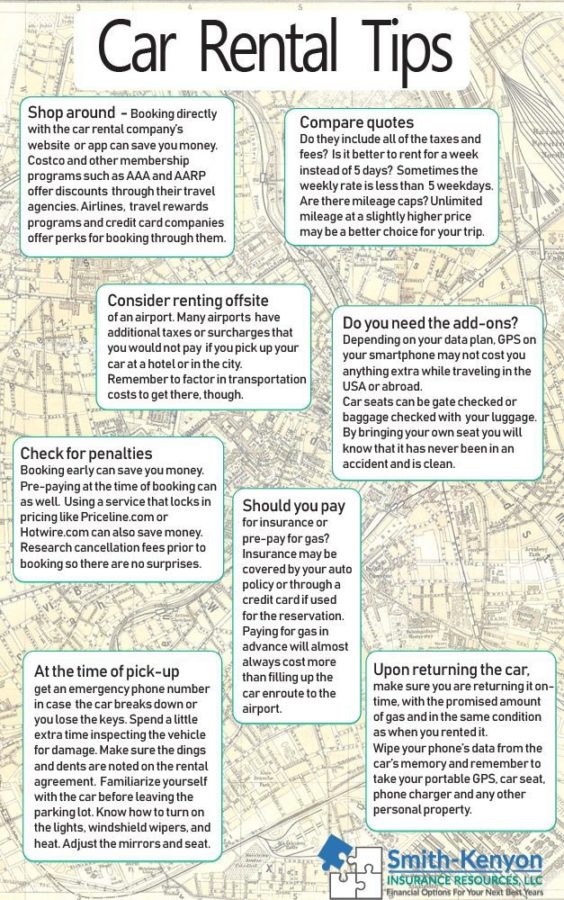Arranging car rentals can be overwhelming. Hopefully, this advice should help you score a cheap rental car for your next trip, whether it’s a quick weekend getaway or a cross-country odyssey.
It’s best to start looking through car rental aggregator sites, which search all the major car rental companies at once. There are dozens of these sites out there, but there’s a lot of overlap between them. These sites include, in alphabetical order, Expedia, Hotwire, Kayak, Orbitz, Priceline, and Travelocity. Before you book through one of these sites, compare their quotes to the rates on the actual car rental site. In some cases, the car rental company will offer you a better deal for booking directly.
For the best auto rental rate, pick up and drop off the rental car at the same location. If you’re taking a road trip, you’ll pick up in one location and drop off in another but be aware this will cost a good deal more.
 Rental cars are graded into classes or sizes by body size. These are usually economy or sub-compact (the smallest), compact, mid-size or intermediate, and standard or full size. Many companies also rent premium and luxury models, convertibles (or roadsters) and sports cars, four-wheel drive or sports utility vehicles (SUVs), and most often mini-vans. Almost all rental cars have automatic transmission, radios and air-conditioning.
Rental cars are graded into classes or sizes by body size. These are usually economy or sub-compact (the smallest), compact, mid-size or intermediate, and standard or full size. Many companies also rent premium and luxury models, convertibles (or roadsters) and sports cars, four-wheel drive or sports utility vehicles (SUVs), and most often mini-vans. Almost all rental cars have automatic transmission, radios and air-conditioning.
In the U.S. you may to reserve the smallest car. Most rental car Websites show pictures of horrible subcompacts in order to entice you to choose a more expensive class of car. But most agencies never stock them. Instead, you are almost always upgraded to a larger vehicle at no additional cost.
Never fall for the counter agent’s upgrades to another car class. In addition, counter agents will often bend the facts to earn a commission when they sell you overpriced insurance. Not only do credit cards provide coverage but your existing car insurance covers a renter. VISA cards usually provide the best coverage.
The biggest national car rental companies include Alamo, Avis, Budget, Dollar, Hertz, National and Thrifty. There are also online travel companies that partner with every major car rental company to help you find the best car rental deals.
 Car rental companies generally charge four types of basic rates: a daily rate with a mileage charge; a daily rate with a limited number of free miles per day; a daily rate with unlimited mileage; and a rate that has free mileage over an extended period. In addition, if you’re choosing between a daily and a weekly rate, round up if you can. Weekly rentals tend to be a better deal but require at least five full days of rental.
Car rental companies generally charge four types of basic rates: a daily rate with a mileage charge; a daily rate with a limited number of free miles per day; a daily rate with unlimited mileage; and a rate that has free mileage over an extended period. In addition, if you’re choosing between a daily and a weekly rate, round up if you can. Weekly rentals tend to be a better deal but require at least five full days of rental.
Any time you rent a car, check the fuel gauge and make sure you fill it up to the same level before you return it. Don’t return it too empty, but don’t return it too full, either. For the best gas prices, opt for self-service pumps. Keep your eyes peeled for Arco gas stations. At Arco, if you pay in cash – which many times is the only option – the prices are usually a lot cheaper than at other gas stations.
Economy cars, aside from being the most affordable option, have the added bonus of saving on gas since they usually get the best mileage. If your car is primarily a way to get from here to there, consider going for this cheapest option.
Many larger vehicle rental agencies have hybrid cars to rent with some renting electric cars. Most major metropolitan airports have at least one car rental service that offers hybrid vehicles. Some online vendors such as Budget, Enterprise, and KAYAK offer hybrid-only searches, allowing you to sort through available models.
Nearly all car rental companies require a credit card to charge additional fees should a defect be found with the car on its return or for road tolls, motoring related fines or missing fuel. In lieu of a credit card some companies require a large cash deposit.
Navigating the add-ons when reserving a car can be daunting. You are required to show financial responsibility for your rental car. However, this doesn’t mean you have to purchase rental car insurance, which can add upwards of $20 to your daily fee. Car rental companies in the U.S. are required by respective state law to provide minimal liability coverage, except in California, where the driver is solely responsible. It’s typical when renting a car to be offered various forms of supplemental insurance and/or damage waivers as an optional extra at additional cost. Many renters are unaware though that their own auto insurance is probably all they need. Check to make sure that your coverage covers rental cars. It’s also possible that your credit card will cover you so check that too.
Many companies offer customers the opportunity to add a roadside service plan for help 24 hours a day, 7 days a week every day of the year including holidays.
There are a few fees that, unfortunately, cannot be avoided. Most states charge state sales tax and may times there’s a tourism surcharge on all car rentals. Many times there are local taxes. These fees should appear on your quote before you reserve the car.
For insurance reasons, some companies stipulate a minimum and / or maximum rental age. In some cases, the minimum age for rental can be as high as 25. In most cases, if you are under the age of 25, you’ll pay a higher rental fee.
Most major car rental companies offer free local maps. Plan your route before leaving the car rental lot to minimize the need to ask for directions.
Travelers should always receive a voucher or confirmation from their travel agent before departing. This document should have a confirmation number, the car rental company name, type of car requested, flight information and date. If the car rental firm is located outside the airport, a telephone number for the courtesy car pick-up should be provided.
